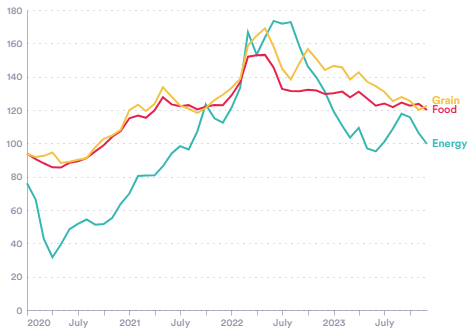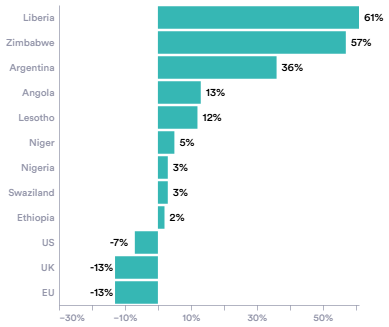The protracted conflict in Ukraine cannot keep food prices rising perpetually. Costs have started receding in the global market, as well as in several advanced economies. But food inflation persists in many developing countries, largely due to domestic challenges that go beyond the Russian invasion.
As Russia’s invasion of Ukraine enters its third year, the humanitarian effects on lives and livelihoods continue to deepen. Although interventions from the United Nations World Food Programme (UN-WFP) and the European Union (EU) have succeeded in pushing global food prices down overall, the effects linger in many developing countries. Many nations, particularly low- and middle-income economies, are still trapped in the food crisis precipitated by the conflict.
Ukraine, which is often referred to as the breadbasket of Europe, is a significant global exporter of agricultural commodities, including grains and sunflower oil. It plays a pivotal role in meeting the food demands of numerous nations.
With prolonged disruption of agricultural production, distribution networks and trade routes, the continuing conflict in one of the most fertile countries in the world has exacerbated existing challenges and created new hurdles for ensuring access to food and improved socio-economic wellbeing for millions of people. The pain of the fighting extends far beyond Ukraine’s borders.
What is the state of food exporting from Ukraine and Russia?
Shortages remain, two years into the war. Several regions that are dependent on agricultural products from Ukraine still face reduced imports to meet their food needs, as well as rising food import bills. For example, besides the EU, most regions experienced a dip in wheat imports from 2021/22 to 2022/23 (see Figure 1). In terms of numbers, South East Asia – one of the largest wheat importers from East European nations – saw the biggest drop in wheat imports from Ukraine.
Figure 1: Change in wheat imports from the 2021/22 to 2022/23 agricultural seasons
The story is different with wheat exports from Russia. It appears that some regions are looking to Russia for more wheat to feed their people. Aside from Europe, South East Asia and Southern Africa, other regions for which data are available witnessed a Russian wheat boom. For example, the region of Eastern Asia (where wheat imports from Ukraine fell by about 66%) increased its imports from Russia by 49%.
This trend is highlighted in Figure 2. The chart shows Russia’s total wheat exports trending upwards, while wheat exports from Ukraine continue to trend down. Rather than die of starvation or suffer malnutrition due to a war, countries (primarily low-income economies) simply ‘follow the food’ to stay alive.
Whether this pattern is replicable for other food products remains to be seen. The picture will become clearer when the World Trade Organization (WTO) releases updated data for other grain commodities (such as maize). What we do know is that with Russian boots occupying Ukraine’s farmlands, the latter’s grain exports, which declined by 24% in 2023/24, are expected to continue to fall further in 2024/25. This suggests that the pattern shown in Figure 2 is likely to persist.
Figure 2: Total wheat exports (up to 1 January 2024)
 Source: WTO, 2024
Source: WTO, 2024
How have food prices changed?
The lack of availability of food, and instability around its supply, will make more people ‘food-insecure’. This will bring with it wider health and social consequences, such as medical conditions associated with malnutrition as well as social unrest and crime.
It is projected that almost 600 million people will be chronically undernourished in 2030 if the war is sustained, with Africa – home to some of the world’s poorest and most hungry populations – hit the hardest. This is around 23 million more people than if the war in Ukraine had not happened. Beyond the vast casualties seen in Mariupol, Kherson and Kharkiv, the human cost of the war is spreading.
Instability in Ukrainian agricultural markets is also manifested in food price fluctuations. Although global food and fuel prices have receded from their peak levels at the inception of the conflict in February 2022, they remain high compared with pre-conflict levels (see Figure 3). Notably, as of December 2023, food and grain prices are still roughly 12-13% above their December 2020 levels.
Figure 3: Commodity price indices

Source:The World Bank, 2024
Price volatility affects importing countries, particularly those with vulnerable populations or limited financial resources to absorb sudden rises in food bills.
Comparing developed and developing economies over the years in which the war has raged, there is a divergence between how domestic food prices have responded to the sluggish downward trend in international markets. Food price inflation (sometime referred to as ‘food-flation’) is easing off in many advanced economies like the UK and the United States, but it is rising elsewhere. This is especially true in more fragile economies (see Figure 4).
Investigating and addressing the causes of this divergence would help to solve some aspects of food insecurity in developing countries, where citizens are taking to the streets in major cities like Kano, Nigeria, in protest against rising food costs.
Figure 4: Percentage change in food prices (December 2022 to December 2023)

Source:Food and Agricultural Organization (FAO) Food Price Monitoring and Analysis, 2024
Not only do food price changes vary across different economies, there are also differences in the effects of price fluctuations on people’s wellbeing. Households in rich economies spend a smaller proportion of their income on food than those in low-income economies, where an average household spends more than half of its wages on food. Higher food prices in such regions cause a greater strain on household budgets, exacerbating poverty and food insecurity in already vulnerable communities.
How has the termination of the Black Sea Grain Initiative affected food security?
There was a brief respite from escalating prices thanks to the UN-brokered ‘Black Sea Grain Initiative’ (BSGI). This policy allowed for the safe passage of Ukraine’s grain exports through three ports: Chornomorsk, Odesa and Yuzhny/Pivdennyi. But the BSGI collapsed in July 2023, with Russia pulling out of the agreement a year after it was first signed. The BSGI facilitated about 20% of Ukraine’s wheat exports getting to developing countries, and its collapse could prove catastrophic.
Alternative trade routes are either expensive or problematic. Disruptions to the Red Sea shipping route – due to recent attacks by Yemen-based Houthi rebels – have reduced trade volumes in the Suez Canal by about 40% (according to a report in The Economist).
Disturbances to these trade routes interrupt supply chains, raising the costs of shipping and warehousing. These costs are often passed on to consumers, putting pressure on domestic food prices and reducing producers’ profits. As fighting intensifies and spreads, and further conflicts bubble up, more and more people stand to lose out.
Since the annulment of the BSGI, of which many food-insecure countries were huge beneficiaries, the UN reports that Russia’s attacks on Ukraine’s ports and export facilities have seen the destruction of about 60,000 metric tonnes of grains – enough to feed about 270,000 people a year. That is more than the combined population of the Seychelles and Kiribati.
What is happening to fuel prices?
Fuel prices influence food prices, especially in monocultural, oil-dependent countries like Nigeria. But increases in energy prices in the international market triggered by sanctions on Russian oil appear to have tapered off (see Figure 3). This comes at a time when there are concerns that the Israel-Hamas war in the Middle East will resuscitate energy price spikes.
But a report from the International Monetary Fund (IMF) suggests that the initial surge in oil prices that followed the start of the fighting in Gaza was due to investor speculations and not to disruptions in production. With continued supply, oil prices are now relatively stable. Unlike the sharp rise in prices that followed Russia’s invasion of Ukraine last year, the warring parties in the Middle East conflict are not significant oil producers.
So, fossil fuel price escalation is not the main driver of the current food-flation. With stable oil prices in the global market, the food inflation still being experienced in many countries is mainly due to issues with food production, processing and pricing, as well as inappropriate or ill-timed economic policies in individual countries.
For example, the unpopular removal of fuel subsidies by the Nigerian government in 2023 quadrupled food prices – an impact far greater than the original effect of the conflict in Ukraine.
What next?
Beyond immediate disruptions, the persistent conflict may have long-term consequences for agricultural productivity in Ukraine and other affected regions. Damage to infrastructure, military occupation of agricultural land, costly movement of agricultural goods, and displacement of farmers could impede future production capacity, prolonging the recovery process (as reported by the IMF) and exerting sustained pressure on local food markets.
In the absence of a miracle, Ukraine’s production and export outlooks look bleak. The country has already lost three planting seasons to war. Without urgent interventions, production and exports will keep dropping from their 2022/23 levels.
More prosperous economies appear to be successful in adapting to and mitigating the food impact of the war in Ukraine. But many developing and emerging economies are still grappling with the food crisis problem. Just like Covid-19, the issue of food insecurity should be a global concern, as ‘hunger in one country is a threat to other countries’.
Concerted efforts must be made to support struggling countries. After all, achieving a world free from hunger and malnutrition is one of the UN’s Sustainable Development Goals (SDG 2). Conflicts around the world are a dangerous threat to meeting this target.
The current food crisis presents an opportunity to learn some vital lessons. Countries that are heavily reliant on Ukrainian grains, such as wheat and corn, must intensify their diversification and self-sufficiency efforts. They could seek alternative suppliers to mitigate potential shortages, as well as creating a secure and business-friendly environment and policies that would allow for foreign direct investment into their own agricultural sectors to chart a course for self-sufficiency in the production of basic food staples.
While the outcome of the war in Ukraine is far beyond the control of many developing and emerging economies, how they react to sustained food shortages is not. An active policy response with international support is vital to protect the most vulnerable households around the world.
The war has claimed many lives already. Keeping the tally of victims of food shortages down to a minimum should be a critical concern for policy-makers worldwide.
Where can I find out more?
- The World Trade Organization regularly releases real-time datasets showing trends and directions of agricultural exports and imports worldwide.
- The International Food Policy Research Institute (IFPRI) hosts a blog series where the impact of global phenomena like the war in Ukraine on food systems is routinely discussed.
- The Food and Agricultural Organization (FAO) has a Food Price Monitoring and Analysis (FPMA) Tool that monitors and analyses food prices in domestic and international markets.




